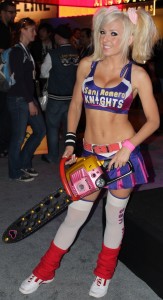Booth Babe Backlash
What a year it was for female gamers, geeks and nerds. The Internet was ablaze, especially during the summer months, over ill-considered tweets, Facebook rants, opinion columns, and harassing flash games that policed women and girls’ participation in traditionally male popular culture. In case you missed it, I’m referring to controversies in game and comic book communities that marked 2012 as the year of misogyny in geek culture. Critical attention to this issue is coming from game and media studies scholars, as well as courageous members of these fan communities. In this post, I add my take on all this misogyny by considering how “the booth babe” contributed to a backlash against female fandom.
It all started long ago, though no one is sure exactly when and where. The brief history of booth babes appearing in The Atlantic, notes the first appearance of spokesmodels at the inaugural Consumer Electronics Show in 1967. However, the use of female promotional models to sell technology is linked to the mid-20th century automobile show and became an international phenomenon, repeated at trade shows around the world. Promotional models are common at expositions for construction tools, audio equipment, guns, cycling paraphernalia, cell phones, cameras, video games, computers, and much more.
The stereotypical booth babe is a temporary employee, hired for event-specific work, which requires standing for hours handing out promotional material and encouraging attendees to approach the product booth. The promotional model is most often, though not exclusively, a woman, and she tends to wear revealing clothing. Or, as demonstrated at the HyperMac booth last week at CES, body paint.
Booth babes may also don costumes worn by characters from the fictional worlds of games, anime, and comics. And thus, like so many female characters from these worlds, often wears Spandex, plate-metal bikinis, or ripped shorts and torn tanks. Photos of booth babes are among the most popular images that emerge from trade show and convention coverage, particularly on fan sites and industry blogs.
During CES 2012, the BBC posted a video about booth babes, which brought the first wave of attention to the phenomenon last year. The video moved swiftly through the Internet, due, in part, to dismissive comments from the president of the Consumer Electronic Association.
In June, game designer and 30-year industry veteran, Brenda Braithwaite, called out Senior Vice President of the Electronic Software Association, Rich Taylor, when she tweeted her dismay at the continued presence of booth babes at the Electronic Entertainment Expo:
“I dread heading off to work at E3 today….It is as if I walked into a strip club w/o intending to. These are the policies of @e3expo and @RichatESA. I feel uncomfortable in an industry I helped found.”
Short-lived attempts to ban booth babes have been made before. The women tech writers appearing in the BBC video and Braithwaite’s tweets provided a much-needed critique of an industrial practice that perpetuates a “boys-only” culture in gaming and technology, and does little to assuage gendered employment and wage discrimination. These moments, and others from last year, reenergized a conversation that deserves sustained attention, organized response, and formal policy changes. However, as summer heated up, the conversation suffered a melt down.
Late one night in June, Destructiod writer Ryan Perez questioned Felicia “Queen Geek” Day’s credibility in a (supposedly alcohol-fueled) tweet: “Does Felicia Day matter at all? I mean does she actually contribute anything useful to this industry, besides retaining a geek persona?” Adding, “Could you [Day] be considered nothing more than a glorified booth babe? You don’t seem to add anything creative to the medium.”
Perez’s Twitter feed was flooded by furious Day supporters, including Wil “King Geek” Wheton, who called Perez an “ignorant misogynist” and demanded Destructiod fire him. They did.
A month after Perez lost his job, Joe Peacock wrote an opinion piece for CNN.com, titled “Booth Babes Need Not Apply,” in which he conflated hired promotional models with female cosplayers. Peacock was apparently disgusted by these “poachers,” claiming “they’re a pox on our culture.”
In November, comic book illustrator Tony Harris ranted on Facebook about “COSPLAY-Chicks” who, in his analysis, are only “quasi-pretty-NOT-hot” and know nothing about comic books. Central to Peacock and Harris’ comments, is the assumption that they have a super power to discern the real female fan from the fake female fan, and the booth babe from the cosplayer.
What these three moments (and many others from last year) reveal is a palatable anxiety from certain dark corners of geek culture. The increased presence of women at cons and expos has sparked a misogynistic backlash. Female cosplayers experience sexual harassment at cons, and are accused of being “attention whores” whose fan knowledge is questioned. Women working in games, comics, and technology attending trade shows are often presumed to be promotional models, and find their creative contributions to the industry dismissed. Standing in the center of this backlash is the booth babe, a misunderstood and misrepresented chimera. She has become a convenient amalgamation and target of many parts of geek culture’s gender problem. It is time to figure her out.



